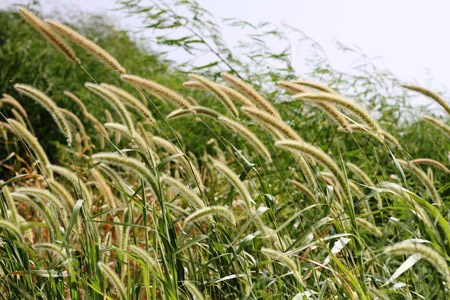
NPS photo/Charles Sassine Padre Island supports 75 plant families composed of almost 400 species. The following are the plant habitats to be found on the island and a few of the species to be found in each. The only state or federally protected plant species, which is known to occur on Padre Island, is considered a species of concern: Roughseed Sea-purslane (Sesuvium trianthemoides).
Learn more about the Wildflowers of Padre Island National Seashore.
Beach The Gulf beach has a very gentle slope and is continually effected by factors such as wind, wave conditions, tides, storm surges, and human traffic in most areas. The beach is almost entirely devoid of vegetation. Marine algae, particularly sargassum weed, are brought up onto the beach by ocean currents. Plant debris and seeds are continually washing up. On the landward edge of the beach, a few salt tolerant plants such as glasswort, sea purslane, and seashore dropseed are established.
Foredunes Landward of the beach along most of Padre Island is a ridge of vegetated coastal sand dunes, composed of sand blown from the beach by onshore winds. These dunes are fairly well stabilized by vegetation, except where wind, water, or human activity have destroyed the vegetation exposing dunes and transforming them into actively migrating forms. The vegetation is a dense cover composed primarily of grasses: bitter panicum, sea oats, gulf dune paspalum, and dropseed. Some of the forbs present are beach morning glory, beach evening primrose, railroad vine, prairie senna, and gulf croton.
Grassland Plants - Low Coastal Sands Behind the belt of foredunes and occupying a major portion of the interior of the island is a low area of deep sand. The land forms vary from almost level to a series of low ridges and hummocky surfaces. The variety of vegetation is greater here than in any of the other habitats on the island. The overall aspect of this area is that of a grassland plain. Gulf dune paspalum, seashore saltgrass, red lovegrass, bushy bluestem, sea oats, and marshhay cordgrass are commonly found. Interspersed among the grasses are many kinds of herbaceous plants. Common forbs are whitestem wild indigo, partridge pea, pennywort, ground cherry, ragweed, croton, phlox, and a variety of composites.
Pond and Marsh Sites The grassland plains are intermixed with poorly drained shallow depressions occasionally inindated with fresh water after rains and sometimes saltwater after hurricanes. Consequently, the vegetation consists of plants tolerant of both saltwater and fresh water and is quite variable depending on the length of time the site is covered and by the type of water covering it. Here can be found marshhay cordgrass, gulfdune paspalum, bulrush, cattails, sedges, starrush whitetop, and pennywort.
Active Dune Fields Along the western edge of the island and in some interior locations are active dune fields continually modified by strong winds. Active dune fields are almost devoid of vegetation. The few plants that can grow in these areas include beach croton, sedge, and sea oats. Wind Tidal Flats The western margin of the island is composed of flats occasionally covered by the waters of the Laguna Madre. Variations in water level are not due primarily to tides, but to the winds. The most drastic flooding results from storm surges and heavy rains. Salt tolerant plants become established on thin layers and low hummocks of sand. These salt tolerant plants include blue-green algae, seashore dropseed, sea heliotrope, sea purslane, sea blite, and glasswort.
Laguna Madre This large, shallow body of water separating Padre Island from the mainland covers approximately 20,000 acres within the National Seashore. Marine grasses are the dominant vegetation: widgeon grass, manatee grass, shoal grass, and halophila. Many species of marine algae are also found in the waters of the Laguna Madre. Some species provide important forage for the many species of plant-eating ducks that winter here.
Spoil Banks The Gulf Intracoastal Waterway outlines a portion of the western boundary of Padre Island National Seashore from markers 85/87 to 195/197. The dredge material from the canal is deposited in disposal areas called spoil banks. Vegetation exists on these, invading slowly and producing an ecological succession if left to natural sequences. Plants found commonly include: sea ox-eye daisy, ragweed, camphorweed, coastal dropseed, bluets, silver bluestem, gulf paspalum, sea blite, beach morning glory, and glasswort.
|
Last updated: September 26, 2016
